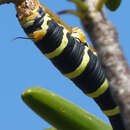pt-BR
nomes no trilho de navegação


Pseudosphinx is a monotypic moth genus in the family Sphingidae first described by Hermann Burmeister in 1856. Its only species, Pseudosphinx tetrio, was first described by Carl Linnaeus in 1771. Its common names include tetrio sphinx, giant gray sphinx, frangipani hornworm,[2] and plumeria caterpillar.[3] In the island of Martinique it is best known as Rasta caterpillar (chenille rasta, in French) because of its colors which are reminiscent of the ones found in Rastafarian clothing and accessories. It is native to the tropical and subtropical Americas from the southern and southwestern United States to Brazil. The occasional individual has been recorded as far north as the northeastern United States.[2]
The adult moth is brown with gray and white markings, and the hindwing is a darker brown. The female may be lighter in tone. The body has gray, white, and black bands. The wingspan is 12.7 to 14 centimeters, and the female is generally slightly larger than the male.[2]
The larva is a caterpillar which may exceed 15 centimeters in length. It is black with aposematic yellow bands and a red-orange head. Toward the posterior end is an orange bump with a black horn roughly 2 centimeters long. The legs are orange with black spots. The pupa is about 7 centimeters long. It is yellow when new, turning brown and darkening to a reddish brown as it hardens.[2]
The moth specializes on plants of the dogbane family, Apocynaceae. Host taxa include Plumeria species such as red frangipani (P. rubra) and white frangipani (P. alba), and golden trumpet (Allamanda cathartica).[2] P. alba in particular is so often infested with this caterpillar that it has been nicknamed "the wormy tree".[3]
The female lays eggs in clusters of about 50 to 100. The caterpillars feed on the plant, detoxifying the poisonous latex present in most Apocynaceae. It pupates in the leaf litter or under the soil. The adult feeds on nectar. It has been recorded on Madagascar periwinkle (Catharanthus roseus) and pequi (Caryocar brasiliense).[2] It has been observed as a pollinator of the fringed star orchid (Epidendrum ciliare) in Puerto Rico.[4]
The caterpillar has several antipredator adaptations. Its consumption of toxic plants makes it distasteful to most predators. An exception is the smooth-billed ani (Crotophaga ani), which tears the caterpillar apart to eat it, avoiding the gut containing the plant material. The caterpillar is also coated in barbed urticating hairs, which stick deeply in skin and cause irritation. If caught, the caterpillar bites.[5]
The species has been known to damage and defoliate Plumeria. Each caterpillar can consume three large leaves per day, and it will continue eating into the branches if it finishes the available foliage. Even in the case of defoliation, the species does not generally kill plants. The caterpillars are large and conspicuous and can be controlled by plucking them from the tree.[2]
Pseudosphinx is a monotypic moth genus in the family Sphingidae first described by Hermann Burmeister in 1856. Its only species, Pseudosphinx tetrio, was first described by Carl Linnaeus in 1771. Its common names include tetrio sphinx, giant gray sphinx, frangipani hornworm, and plumeria caterpillar. In the island of Martinique it is best known as Rasta caterpillar (chenille rasta, in French) because of its colors which are reminiscent of the ones found in Rastafarian clothing and accessories. It is native to the tropical and subtropical Americas from the southern and southwestern United States to Brazil. The occasional individual has been recorded as far north as the northeastern United States.
Le Sphinx du frangipanier (Pseudosphinx tetrio) est une espèce néotropicale de lépidoptères de la famille des Sphingidae. Elle est l'unique représentante du genre monotypique Pseudosphinx .
La chenille est de grande taille, à rayures de couleur jaune et noire et à tête rouge-orange. Sur l'arrière du corps, elle possède un filament qui oscille dans un mouvement de va-et-vient lors de sa marche.
Le papillon est de grande taille, gris avec de gros yeux noirs.
La chrysalide.
Avers du mâle
(coll.MHNT)
Revers du mâle
(coll.MHNT)
Avers de la femelle
(coll.MHNT)
Revers de la femelle
(coll.MHNT)
Son aire de répartition s'étend du Sud du Brésil au Sud des États-Unis (notamment le Texas et la péninsule de Floride) via l'Amérique centrale, le Mexique et les Antilles[1]. L'espèce est notamment présente aux Antilles françaises[2].
L'espèce Pseudosphinx tetrio a été décrite par l’entomologiste suédois Carl von Linné en 1771, sous le nom initial de Sphinx tetrio[3]. Son genre actuel Pseudosphinx, dont elle est l'espèce type et l'unique espèce, a été décrit en 1856 par l'entomologiste argentin Hermann Burmeister.
Pour l'espèce :
Pour le genre :
Cette espèce très vorace consomme les feuilles de frangipanier (Plumieria rubra) et d'allamanda, arbres qui peuvent être défoliés en quelques jours. Elle est communément appelée « chenille gloutonne » car elle mange des quantités astronomiques : jusqu'à deux fois son poids en 24 heures.
Le Sphinx du frangipanier (Pseudosphinx tetrio) est une espèce néotropicale de lépidoptères de la famille des Sphingidae. Elle est l'unique représentante du genre monotypique Pseudosphinx .
Pseudosphinx is een geslacht van vlinders uit de onderfamilie Macroglossinae van de familie pijlstaarten (Sphingidae).
Pseudosphinx is een geslacht van vlinders uit de onderfamilie Macroglossinae van de familie pijlstaarten (Sphingidae).
Pseudosphinx este un gen de molii din familia Sphingidae.
Pseudosphinx este un gen de molii din familia Sphingidae.
Pseudosphinx là một chi bướm đêm thuộc họ Sphingidae.
Pseudosphinx là một chi bướm đêm thuộc họ Sphingidae.